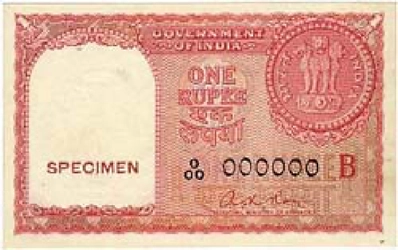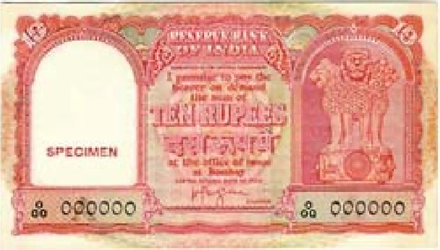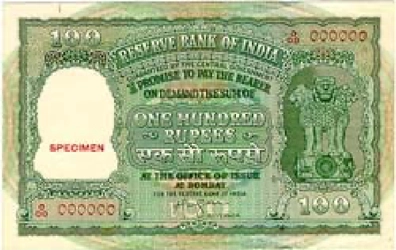 IST,
IST,
Others
By the end of the Nineteenth Century, India could broadly be divided into British India, the Princely States, the Portuguese Territories (Goa, Daman & Diu), and the French Territory of Pondicherry.
While many Princely States were issuing their own coinage, only two viz., Jammu & Kashmir and Hyderabad actually issued Paper Currency. Both the Portuguese and French Territories issued Paper Money. Burma, where the Reserve Bank had an office at Rangoon, was politically separated from India on April 1, 1937. The Indo-Burma Monetary Arrangements provided for the RBI to continue to manage the currency of Burma.
During the Second World War many petty Princely States issued emergency tokens which are alluded to as 'Cash Coupons' in lieu of coins. Emergency Money was also issued in Burma after the end of the Japanese occupation to facilitate exchange.
Traditionally Indian money had enjoyed wide circulation in the Persian Gulf Region. India had also issued notes for circulation in the Persian Gulf region as well as special notes for Haj Pilgrims.
Burma Issues
One of the curiosities of Note issue history is that the Reserve Bank of India issued notes that were not legal tender in India. Rangoon, the capital of Burma, was one of the original currency circles of the Office of the Controller of Currency. Burma separated from India in 1938; however, the Reserve Bank of India acted as Banker to the Government of Burma and was responsible for note issue in terms of the Burma Monetary Arrangements Order, 1937. In May 1938 the Bank issued distinctive Burma notes which were not legal tender in India. June 1942 saw the occupation of Burma by Japanese which lasted till 1945. Thereafter, monetary matters were looked after by the British Military Administration of Burma. The Reserve Bank recommenced its Rangoon Office in 1945 and carried on functioning as banker to the Government of Burma till April 1, 1947.
Reserve Bank of India, Rangoon Office
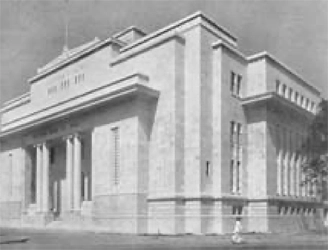
Notes issued by Reserve Bank of India for Burma
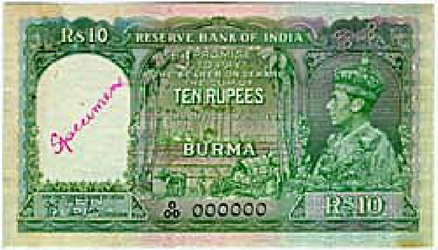
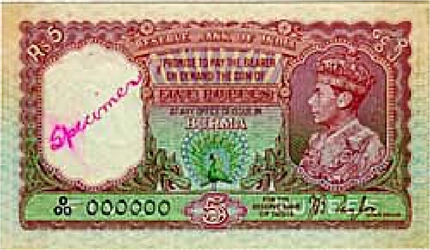
Emergency Issues Princely States : Cash Coupons
The Second World War led to a diversion of resources into the war effort. The Mints were no exception and their capacity was increasingly used to mint coins for “Imperial Purposes”. By 1942, an acute scarcity of small coins was felt throughout India. While British India managed with postal surrogates, petty princely states in Western India like Balvan, Bikaner, Bundi, Gondal, Indergadh, Junagadh, Jasdan, Kutch Mengni, Muli, Morvi, Mangrol, Nawanagar, Nawalgarh Palitana, Rajkot, Sailana, Sayla, Vithalgadh, issued what are alluded as Cash Coupons to meet the shortage. Most Cash Coupons were printed crudely on press board. Their place in the history of Indian Paper Money is in the realm of exigent money (Emergency issues). Incidentally, only two princely states had issued paper currency - Jammu & Kashmir in 1876 and Hyderabad commencing from 1918. While the Government of Kutch had prepared specimens of currency notes, these were not issued.
Bundi (Now in Rajasthan)
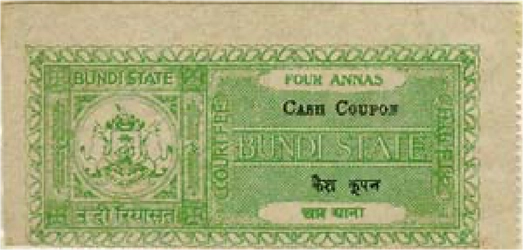
Bikaner (Now in Rajasthan)
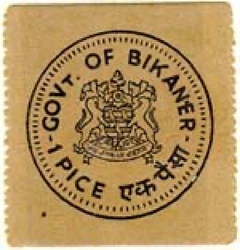
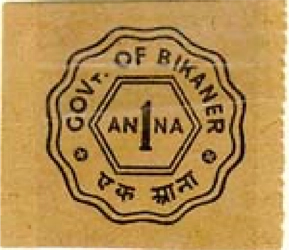
Junagadh State (Now in Gujarat)
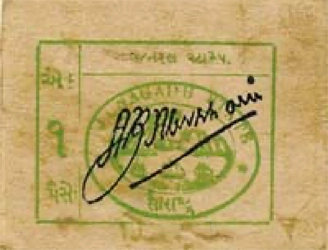
Mengni (Now in Gujarat)
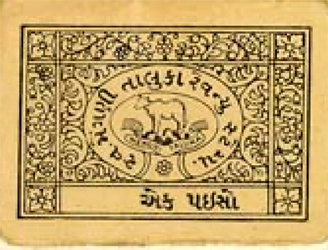
Nawanagar (Now in Gujarat)
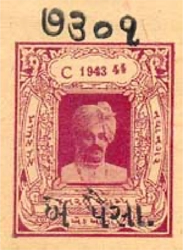
Sailana State (Now in Madhya Pradesh)
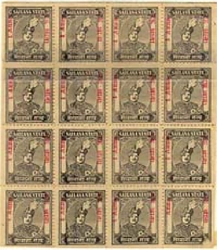
Sayla State (Now in Gujarat)
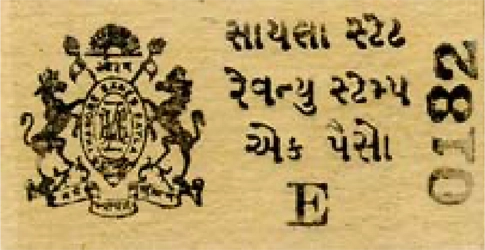
Haj Issues
The Indian Government also issued notes for the use of the Haj Pilgrims from India in Saudi Arabia. These notes were issued in denominations of Rupees Ten and Hundred, and had the word HAJ inscribed on the obverse. The Serial Number of the notes was prefixed with the letters ‘HA’. The notes were discontinued when the notes meant for circulation in the Gulf States were withdrawn.
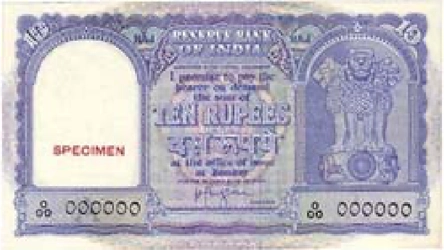
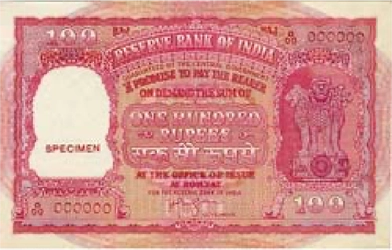
Hyderabad Issues
The Princely State of Hyderabad was founded around 1724 when Mir Qamar-ud-Din, the Mughal Viceroy of the Deccan, assumed independence under the title of Asaf Jah and founded the dynasty of the Nizams of Hyderabad. In the post 1857 era, the state of Hyderabad was one of the largest Princely States in India and later came to be known as the 'Dominion of His Exalted Highness, the Nizam'. The State which covered territories presently included in Andhra Pradesh, Maharashtra, and Karnataka was assimilated into the Indian Union. In matters of currency and coinage, the coins of the Nizams were issued in the name of the Mughal Emperor till 1858. Thereafter, they were struck independently and the new coins were termed the 'Hali Sicca', i.e., the current coins. Where paper currency was concerned, the Government of Hyderabad had made several state led efforts to organise private bankers and local 'saukars' in the Dominion to set up a banking company which could issued paper money, amongst other activities. These attempts to issue paper currency proved abortive, in the wake of British resistance to Indian States issuing paper currency. The exigency of the First World War, the Indian and Hyderabad contributions to British war effort, and an acute shortage of silver on the subcontinent led the Dominion to get its way in 1918 and paper currency was issued under the Hyderabad Currency Act. Notes were issued in denominations of Rupees 100 and Rs 10. The currency was designated the Osmania Sicca and the notes were printed by Messrs Waterlow and Sons. Rupee One and Rupees Five notes were issued subsequently in 1919 and Rupees One Thousand notes were issued in 1926. After the setting up of the India Currency Notes Press at Nasik, Hyderabad notes came to be printed there for reasons of economy and security. Hyderabad acceded to the Indian Union after police action. The Osmania Sicca was demonetised in 1959. With the reorganisation of states on a linguistic basis the State of Hyderabad ceased to exist.
Rupee Five Note (Obverse & Reverse)
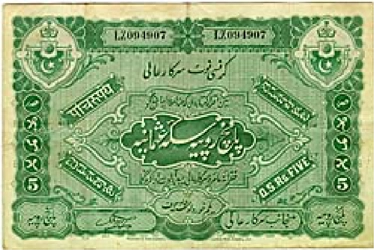
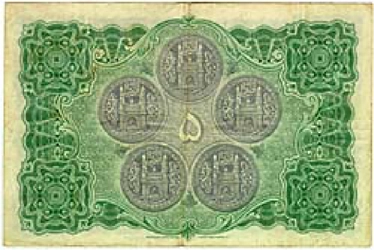
Rupee Ten Note (Obverse & Reverse)
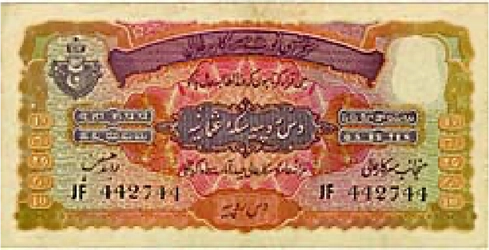
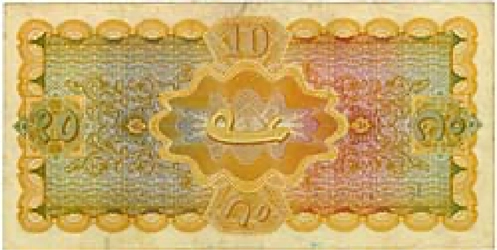
Indo-French Issues
The Portugese thwarted early French designs to establish trade interests in India and the East. In 1664, Jean-Baptiste Colbert, the French Minister of Finance succeeded in establishing the first viable French Company (the French East India Company) during the reign of Louis XIV. The company established its factory at Surat in Western India and acquired a foothold in Southern India by acquiring Pondicherry in 1674. The disintegration of the Mughal Empire and the rivalry of local powers that strove to fill the vacuum, provided fertile ground for the English and the French to precipitate the Anglo-French struggle in India. As a result, the French lost most of their territories. The French territories were transferred to the Indian Union. De facto transfer of Pondicherry took place on 1st November, 1954 and de jure transfer on 28th May, 1956. Banque De l’Indochine issued paper money for the French in India, under decrees, which find mention on the notes. The earliest ‘Roupie’ denominated notes were issued in 1898. The Roupie consisted of 8 Fanons and one Fanon was equivalent to two annas. These were in the denomination of 50 and 10. Notes of One Roupie were issued immediately after the First World War. New notes of 50 Roupies carried the bust of Dupleix, who founded the French Empire in India. These notes continued to be in circulation till they were replaced by Indian currency in 1954.
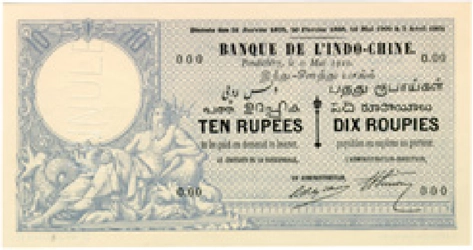
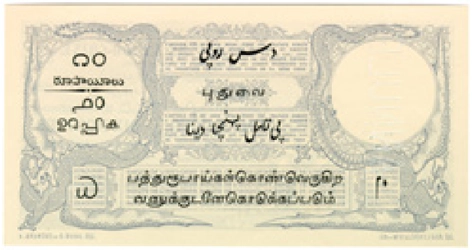
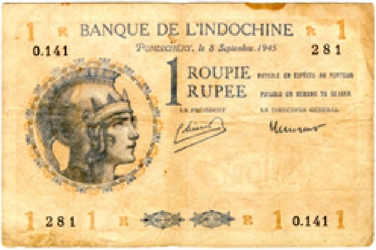
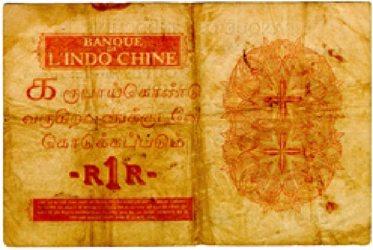
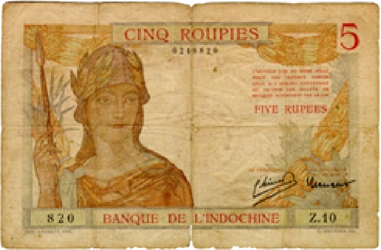
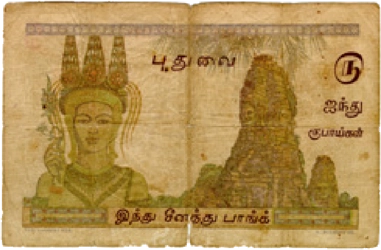
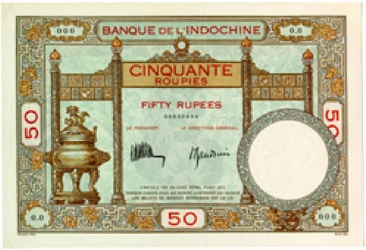
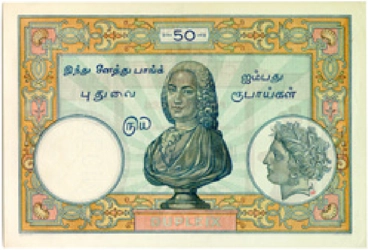
Indo-Portuguese Issues
India had extensive links with the Hellenic and Roman civilisations between the 4th century BC and the 4th Century AD. Alexander’s invasion of the Punjab gave rise to the Hellenic links and very considerable maritime trade established links with the Roman Empire. Renewed contact with the West began with the arrival of the Portuguese navigator Vasco da Gama at Calicut in 1498. Francisco de Almeda and Afonso de Albuquerque helped establish and consolidate Portuguese power in India and the East. The territory of Goa in western India was seized in 1510. The Portuguese enjoyed virtual monopoly of trade with India for more than a century till the arrival of the Dutch and the English. They, however, retained the territories of Goa, Daman and Diu till 1961. The first Indo-Portuguese issues of paper currency were the ‘Rupia’ denominated notes put into circulation around 1883. These notes incorporated the portrait of the King of Portugal. These were issued in denominations of 5,10,20,50,100 and 500. In 1906, ‘Banco Nacional Ultramarino’ was entrusted with the responsibility of issue of paper money in India for the Portuguese held territories. The early notes issued by the bank carried the seal of the bank. New denominations of 4 Tangas, 8 Tangas and One Rupia and 21/2 Rupias were introduced in 1917. Most issues carried the Commerce and Sailing Ships motifs common to many colonial issues. Indian symbols and motifs (architectural and exotic fauna) were adopted on some notes. Later notes carried the portrait of Afonso De Albuquerque. The monetary system in vogue in Goa consisted of the Reis, the Tanga and the Rupia with one Rupia consisting of 16 Tangas. In 1959, the denominational unit was changed from Rupia to Escudos with one Escudo consisting of 100 Cent avos. New notes with the denominations of 30, 60, 100, 300, 600 and 1000 were introduced. These remained in circulation till 1961. When Goa was annexed to the Indian Union, these notes were replaced by Indian currency.
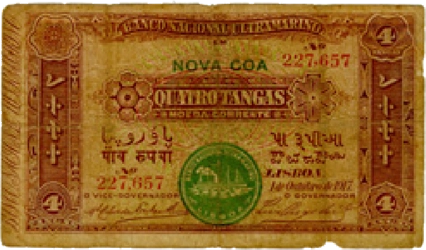
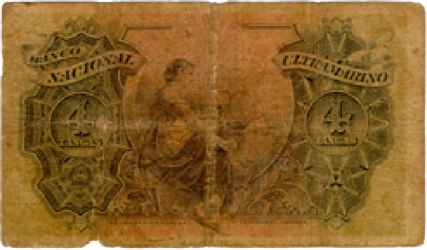
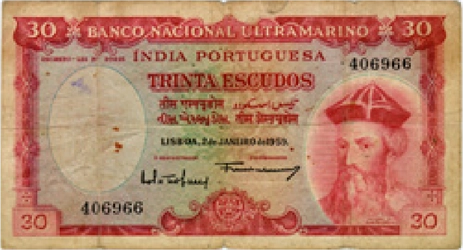
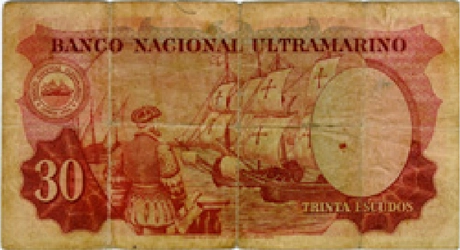
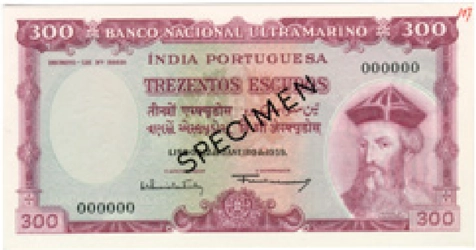
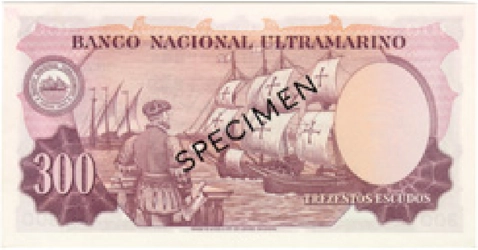
Jammu & Kashmir Issues
On the decline of the Mughal Empire, Kashmir was annexed by the Afghans and later in 1819 by the Sikhs and in 1845 by the British. In 1846, Gulab Singh was confirmed the Feudatory Chief of Jammu & Kashmir by the British. In 1947, the Maharaja opted to Merge with the then Dominion of India.
Paper Money was issued sometime in 1877 in the reign of Maharaja Ranbir Singh on watermarked paper. The notes were not very popular and were in circulation for a very short period. The notes carried the ‘Sun’ motif of the Dogra family.
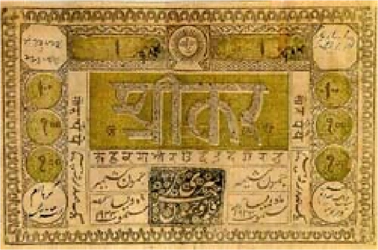
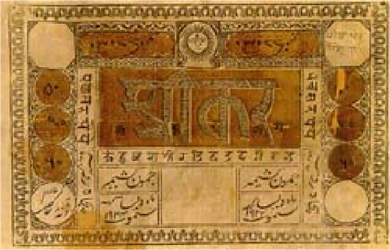
Persian Gulf Issues
The Indian Rupee and consequently the paper money issues traditionally enjoyed wide currency in the Persian Gulf. On presentation by banks in these areas to the Reserve Bank, these notes were redeemable in foreign currency equivalent.
On achieving independence, India started of with a comfortable foreign exchange position. The quest for development and the demands of ‘catching up’ laid considerable stress on the foreign exchange position. The scarcity situation that ensued led to possibilities of exploiting the traditional currency arrangements with the Gulf. To obviate or at least mitigate malpractices, which such an arrangement could give rise to, a separate series of notes exclusively for circulation in the Gulf (Kuwait, Bahrain, Qatar, and the Trucial States (now the UAE) were issued by the Indian Government and the Reserve Bank of India in the 1950’s. The notes retained the contemporary design but were different in colour and carried the prefix ‘Z’. The notes were issued in the denominations of Rupee One, Rupees Ten and Hundred and were redeemable only at the Bombay office of issue. As the Gulf States issued their own currency, these notes were withdrawn over a period of time from the early 1960’s and ceased to be used around 1970.
